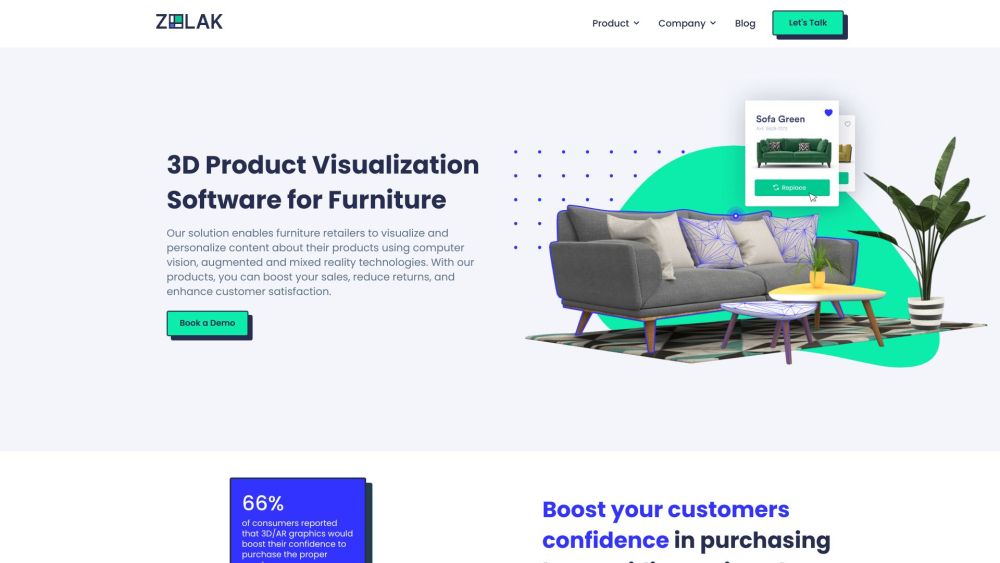Zolak: 3D Furniture Visualization & Personalization Software
Zolak is an innovative 3D product visualization software for furniture retailers. It utilizes computer vision and AI technologies to enhance the shopping experience for customers by allowing them to visualize and personalize furniture products.


Understanding Zolak
Zolak is a cutting-edge 3D product visualization tool specifically designed for furniture retailers. By leveraging advanced computer vision and AI technologies, it enhances customer shopping experiences by enabling them to visualize and customize furniture products effortlessly.
Using Zolak
Key Features of Zolak
Zolak offers: 3D product visualization, augmented and mixed reality technologies, computer vision, personalized digital experiences, virtual showrooms, interactive showrooms for retail websites, furniture try-on solutions, customizable product options, photorealistic visuals, accurate sizing and scaling, an intuitive interface, accelerated content creation, bridging online and offline shopping, and increased engagement and retention.
Applications of Zolak
Furniture retailers can utilize Zolak to: increase sales and customer confidence, reduce returns, enhance the overall shopping experience, offer self-service tools, provide personalized digital interactions, improve conversion rates, raise average cart values, decrease return rates, boost customer loyalty, and save on interior design costs by creating digital spaces.
-
Customer Support & Contact Information
For support and inquiries, visit the contact us page.
-
About Zolak
Company: Zolak Tech
Learn more about Zolak by visiting the about us page.
-
Follow Zolak on LinkedIn
Connect with us on LinkedIn: Zolak Tech LinkedIn
Frequently Asked Questions (FAQ) about Zolak
What is Zolak?
Zolak is an advanced 3D product visualization software aimed at furniture retailers, utilizing AI and computer vision to provide an enhanced shopping experience.
How to use Zolak?
Retailers can integrate Zolak into their online platforms, offering customers interactive and virtual reality experiences to visualize and customize furniture products. Zolak Vision allows users to visualize new furniture in their own space.
What is a 3D product visualizer?
A 3D product visualizer allows customers to view products in three dimensions, providing a realistic preview of the product.
What is AR 3D product visualization?
AR 3D product visualization uses augmented reality to create interactive and realistic product visualizations, viewable in real-world environments via smartphones or tablets.
What is product visualization for ecommerce?
Product visualization for ecommerce uses technologies like CGI, 3D modeling, computer vision, and augmented reality to create realistic representations of products for online stores.
What are product visualizations for ecommerce used for?
These visualizations help customers better understand products, reducing returns, enhancing satisfaction, and boosting sales.
How are product visualizations for ecommerce created?
They are created using 3D modeling, computer vision, and AR technologies to produce realistic and interactive product representations.
Can CAD software be used to create a customizable product visualization tool?
Yes, CAD software can be used to create tools that allow customers to customize and view products from different angles before purchasing.
How can a company benefit from using 3D product visualization services for ecommerce?
Companies can offer customers a realistic and personalized viewing experience, reducing returns, increasing sales, and saving on photoshoot and prototype costs.
What is the role of visual effects in product visualization for ecommerce?
Visual effects make products appear more lifelike, showcasing design and functionality while creating an emotional connection with the customer.
What are some examples of 3D product visualization?
Examples include 360-degree views, virtual try-on features, and product configurators.
How has product visualization evolved in recent years?
Advancements in AI, computer vision, and AR have enabled more realistic and interactive product visualizations, improving the shopping experience.